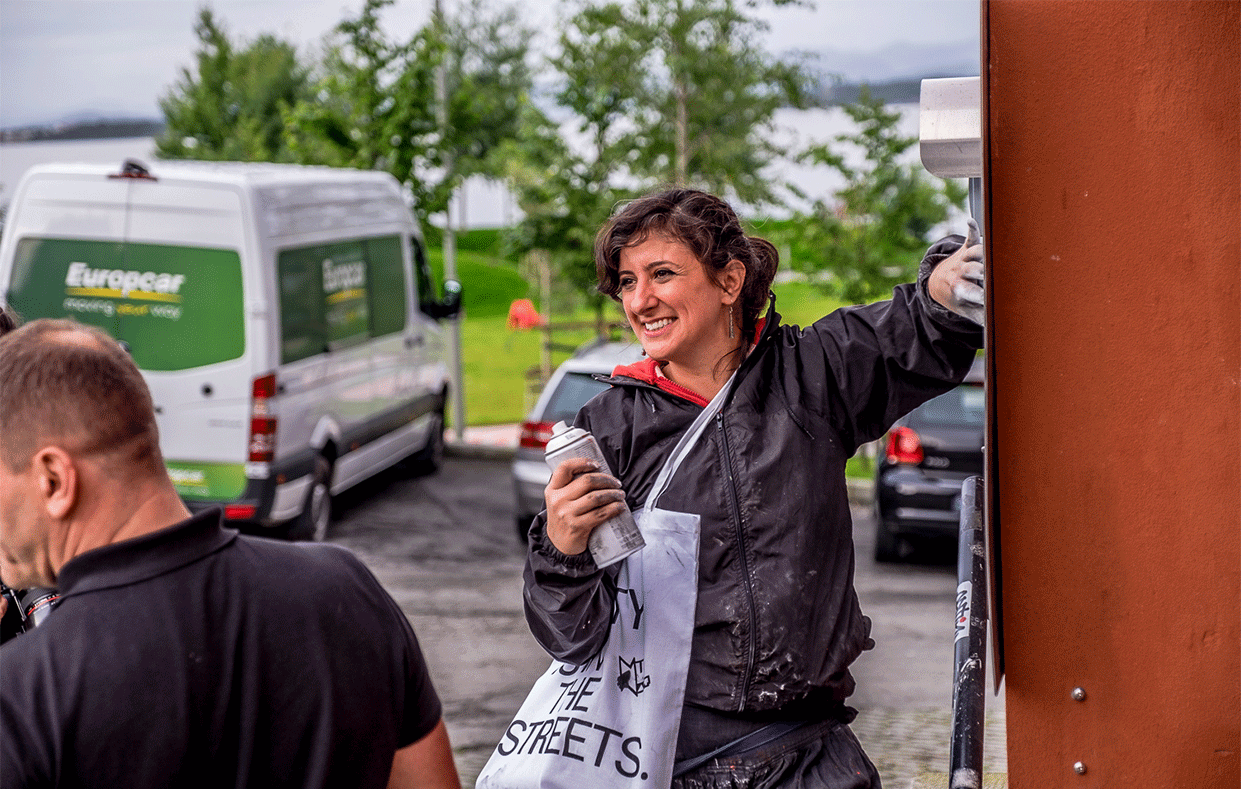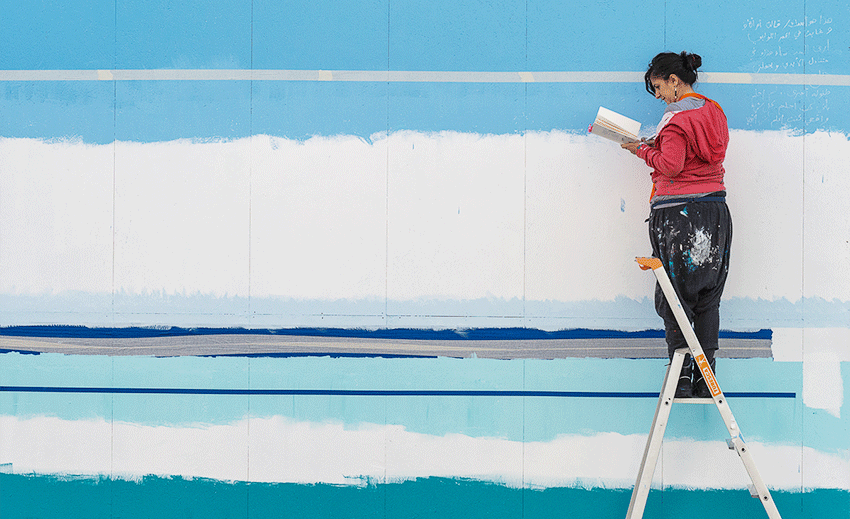Transcribed interview by Visual Collaborative
March 2019 9 min read
Photo by Ryan Lash
Bahia Shehab is a Lebanese-Egyptian artist, designer and art historian. She is associate professor of design and founder of the graphic design program at The American University in Cairo, where she has developed a design curriculum focused on visual culture of the Arab world. As one of the main features on Visual Collaborative’s “Polaris“ interview series, Shehab speaks on her expanding perspective, calligraphy work and forthcoming book.
Following the success and notoriety of the campaign “A Thousand Times NO” since the Arab spring, do you ever get weary being asked or talking about it? Has the mission and awareness for this initiative been accomplished?
(Bahia) No – [Bahia repeats three times]. We still have a very long way to go. Its a life long struggle for me “A thousand times no” is my first child. Its like asking me if I would ever get tired of talking of my first child. No mother would, the campaign is my first child. The term NO still needs to be told to many tyrants around the world, so many terrible ideas we are still living in. I feel its relevant and I will keep saying no till the day I die. So many generation of women and men coming along need to keep saying no till we fix things.
Overcoming the barriers of fear, tell us about social techniques you witnessed during the uprising that could be transported to other parts of learning when it comes to the process of design?
(Bahia) During the uprising, I was founding the design program at the AUC (American University in Cairo) and I was very lucky that these two processes were taking place at the same time in parallel. There was a lot of learning, building a program in such difficult times, the lack of resources and the general atmosphere not being able to say you wanted to say.
It was such an interesting time with people putting themselves and feelings out on the street.
The systems that were created on the street were difficult to capture because there were so many problems on various degrees, but what we were able to capture was the spirit of defiance.
There were so many experiences, it would be difficult to pinpoint. One example is combination of all those experiences channeled in a course, I am presently teaching; Designing for Eternity. I am teaching my students how to decode systems based on the concept of eternity. Eternity is about sustainability, eternity is about kindness, eternity is about beauty. I live in Egypt with biological artifacts and stories that has existed for thousands of years. How can we design systems that last forever.

Photo by Mark Nicholas of Bahia painting NO Mural – Freiburg-Germany
As an activist who has put together curriculums (graphic design program), how do you respond to any communities or persons who label activists or artist as individuals claiming being victimized?
(Bahia) Let me explain, the term activist today is so overused, its an abused term. If you call me an activist now it is almost an insult. Activist means many things and then there are many varying degrees. There is no single image of what activism looks like. Look at the revolution, we don’t call ourselves activists, we call ourselves humans. There are different levels of contributing to a cause. It does not have to fall under one umbrella. You can simply create awareness in your society. As long as you care for something other than putting money in your pocket. I think everyone is an activist. If you can think about animals or human rights or even the environment then you are an activist. Even sharing a simple online post of someone who needs medication, the simple things. There is only the spectrum and not the label.
Congratulations on being a recipient and Laureate of The Prince Claus Award and others, can you tell us how that came about and what it means for others in the Mideast?
(Bahia) The awards are an indication of being on the right track. Opening the doors for women around the world especially in my part of the world. I didn’t have many role models in my part of the world, so these awards are really about paving the way for women who aspire to make there own dreams a reality.
A thousand times no, its is a rejection of our state. Rejecting the colonial part of the world, and all the wars pushed on us. With a rich and vibrant history, we do not deserve this kind of label.

Photo by Brian Tallman NUART Street Art Festival Stavanger-Norway
You identify as Egyptian and Lebanese, two very active places that have very rich cultures. In your quiet or noisy moments how do you get inspired. What makes Bahia create the work she does. Are you in any form spiritual or physiological driven like many artists for muses?
(Bahia) The people. I work for the people, they inspire me. I made A thousand times no, its is a rejection of our state. Rejecting the colonial part of the world, and all the wars pushed on us. With a rich and vibrant history, we do not deserve this kind of label. I didn’t even consider myself an artist, I really was only rejecting my reality. I get my voice through art. Its hard to confine myself into one box. As an artist I use my disciplines as a tool to get my message out.
Arabic typography and calligraphy have a special place with translations, especially with oral stories or narratives, which may not have been widely available to the public. What provisions are being made by the Islamic art community, to create an accessible archive for future generations?
(Bahia) On the technical level of accessibly and research its such a wide question. It would take me 3 books to really articulate my thoughts. I am creating a library, a visual encyclopedia for historians, type designers and artists who need to create fonts and are interested in accessing the arabic script. It is the compilation of over 70 thousands of literature and scripts we have traced. The web has a diversity problem. I would love to increase access to arabic typefaces online. We need to start crowdsourcing our solutions because of the massive undertaking.

Photo by Bahia Shehab, Mural-“We will be who we want to be the journey has not started and the road has not ended” Mediamatic, Amsterdam-The Netherlands
At this stage of your professional career of accomplishments and commitments, If you could work alongside any creative, public figure or company, who would it be and why?
(Bahia) Elon Musk! [Bahia laughs] I just like how he defies government. It is nice to see someone who can dream this big (Talking about mars). Let us take humanity to another planet. But I am no sure. I am so focused on my part of the world. It would be when I meet the right people. I am so focused on my region, I don’t have enough role models to reach out to. I feel I meet the right people at the right time. My process is driven by external factors, the right people come along at the right time and this helps me manage my expectations.
As an associate professor at the American University in Cairo, what are the common challenges of teaching professional students, people from society who learned design from the internet before design curriculums were official in place?
(Bahia) This is such a lovely question. Thank you! I try to change my modules to accommodate and challenge the different kinds of students, they have changed over the past 8 years. I can tell the big difference between all the students coming in, compared to when we first started. I consider myself a mediator and not a teacher. Most of my classrooms are flipped, we learn by doing. They teach me and then we learn together. Its not a “top-down kind” of learning. I don’t want my students believing knowledge is only from one place. I want them to be life long learners.

Photo by aurallan, Mural- “I will dream” Institut des Cultures d’Islam, Paris-France
From your vantage point spear heading programs at AUC, what can you tell the world about ancient Egypt or a specific dynasty that would be of value to the world beyond the notoriety of the pyramids.
(Bahia) The technology of living is not limited to digital and it is very advanced. There are technologies we are no longer able to tap into, I really believe that. These ancient technologies were tuned in to nature, they worked with it. We were not dependent on fuel energy. Look at the waterways and the architecture of houses that regulate heat and airflow. We didn’t need air conditioners, we build structures working with nature. Our systems of consumption are not sustainable. Big businesses are concerned with making money. We need to look at ancient cultures and the solutions they applied.
We were not dependent of fuel energy, we worked with nature. Look at the water ways and the architecture of houses that regulate heat and airflow
We didn’t need air conditioners, we build structures working with nature. Our systems of consumption are not sustainable. Big businesses are concerned with making too much money. We need to look at ancient cultures and the solutions they applied because we have so many species or people and living organisms.
You are not in support of capitalism?
(Bahia) Definitely not. It has proven its failure. Look around you. The rivers are polluted. Why should I buy my water in a plastic bottle? It defies common sense! How did we get to this?
What kind of work or upcoming projects can the world expect from Bahia Shehab within the next 5 years?
(Bahia) Do you want concrete projects or theoretical ones? [Bahia laughs]. I think I have things lined up for the next 5 to 10 years. I am working on releasing a book, three books actually which will be coming out hopefully soon. The soonest one is going to be documenting a series of walls I have painted on, in different cities around the world. The walls I paint are poetry by Palestinian poet Mahmoud Darwish, I have painted in Paris, New York, Tokyo, Marrakesh and at the Shangri La Museum in Honolulu amongst others. The book will contain the stories and because there was no funding it will also cover stories of the kindness of people who helped me. This book is entitled At the Corner of a Dream coming out hopefully later on this year. I also co-authored another book A History of Arab Graphic Design featuring 80 designers from the arab world from Morocco to Iraq (100 years on Arab design). In terms of artwork, there are quite a few, I will be doing the Bellagio residency this summer. At the Bellagio I will be researching marriage contracts exploring monogamy and polygamy and likely will be doing artwork around that.
More information on Bahia’s forthcoming book A History of Arab Graphic Design can be ordered on Amazon.
